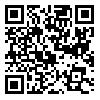Volume 4, Issue 4 (3-2022)
2022, 4(4): 0-0 |
Back to browse issues page
university health ilam
Abstract: (1082 Views)
Introduction: Any kind of behavior or practice that conflicts with the values and norms accepted by the community is known as social harm, which can disrupt the function of the individual, the family and the community. The aim of this study was to investigate the social injuries of dormitory students and its effective factors among dormitory students.
Materials & Methods: This descriptive-analytic study was carried out on 337 dormitory students of public universities in Ilam. A researcher-made questionnaire (69 items) was used to collect data. To evaluate the validity of the instrument from face validity, the relative content validity coefficient (CVR), Content validity index (CVI) was used. In this study, the CVI value was 0.85 and CVR was 0.76. The reliability of the questionnaire was assessed by Cronbach's alpha coefficient, which was 0.87.
Data were analyzed using SPSS software version 20 and descriptive statistics were used to describe the data. Inferential statistics were used to analyze the data.
Findings: Chi-square test showed a significant difference between the damage of illegitimate relationships with students' gender (p<0.05). There was a significant relationship between the status variables of friends, the lack of familiarity with living skills, lack of academic and educational facilities in dormitories and the occurrence of social injuries in the study population (p <0.05).
Discussion & Conclusion: In this study, having family problems, history of depression, existence of peer group and friends and distant students from family safe environment were introduced as the most important factors affecting social harm in students. Therefore, it is suggested that to develop appropriate strategies, increase cultural and recreational programs in order to prevent Social harm.
Materials & Methods: This descriptive-analytic study was carried out on 337 dormitory students of public universities in Ilam. A researcher-made questionnaire (69 items) was used to collect data. To evaluate the validity of the instrument from face validity, the relative content validity coefficient (CVR), Content validity index (CVI) was used. In this study, the CVI value was 0.85 and CVR was 0.76. The reliability of the questionnaire was assessed by Cronbach's alpha coefficient, which was 0.87.
Data were analyzed using SPSS software version 20 and descriptive statistics were used to describe the data. Inferential statistics were used to analyze the data.
Findings: Chi-square test showed a significant difference between the damage of illegitimate relationships with students' gender (p<0.05). There was a significant relationship between the status variables of friends, the lack of familiarity with living skills, lack of academic and educational facilities in dormitories and the occurrence of social injuries in the study population (p <0.05).
Discussion & Conclusion: In this study, having family problems, history of depression, existence of peer group and friends and distant students from family safe environment were introduced as the most important factors affecting social harm in students. Therefore, it is suggested that to develop appropriate strategies, increase cultural and recreational programs in order to prevent Social harm.
: Cross sectional |
Received: 2021/12/15 | Accepted: 2022/03/1 | Published: 2022/04/30
Received: 2021/12/15 | Accepted: 2022/03/1 | Published: 2022/04/30
| Rights and permissions | |
 | This work is licensed under a Creative Commons Attribution-NonCommercial 4.0 International License. |


